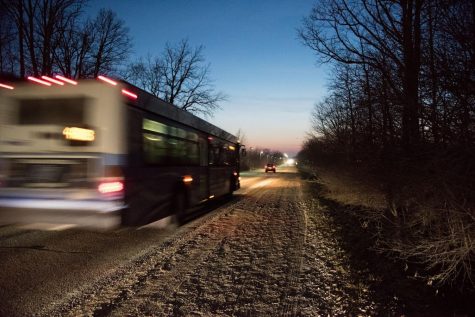GV looks toward busing in 2020
Jan 27, 2020
July 1, 2019 through the first week of Jan. 2020 saw nearly a million rides on The Rapid through Grand Valley State University routes. However, shifting ridership and various improvements accompany college busing.
“Over the last five years, GVSU ridership has decreased as it has systemwide for The Rapid, as well as nationwide,” said Chris Swank, Manager of Operations for Facilities Services.
According to GVSU Transportation Services, nearly 2.7 million rides occurred on GVSU routes in 2015. By contrast, less than 2.2 million rides happened during 2018. Swank said parking permit sales have increased as more individuals drive to campus while gas prices have been low since GVSU’s peak ridership, partially explaining the slip in ridership.
Swank mentioned some people have indicated packed busses as their reason for not riding. Bus capacity limits how many commuters can be safely transported, and he said The Rapid’s traditional 40-foot busses fit between 40 and 60 passengers sitting and standing. With a full bus, students may need to wait for another bus.
“In the morning to get to class, they are a bit packed and it’s a bit uncomfortable,” said junior GVSU student Aisha Hoskins.
Hoskins said she rides The Rapid daily to classes and work, going from Campus West to Allendale and sometimes downtown Grand Rapids. Despite crowded morning buses, she described her rides as always quick and not that bad.
However, Swank said ridership had risen for Route 85, which combines Routes 37 and 48 for weekend and evening services. Last year, an additional bus was added to Route 85. This is not the only change to the GVSU side of The Rapid’s operations.
“We are excited for the launch of the Laker Line as it will improve the Route 50 experience,” Swank said.
The Laker Line will begin next fall, utilizing 60-foot buses. Each longer bus will be able to support between 60 and 80 commuters, Swank said. To accommodate the larger vehicles, the Laker Line has new platforms installed from the Cook-DeVos Center for Health Sciences to Kirkhof Center.
Swank said the platforms will be leveled with the busses while allowing commuters to simultaneously use front and rear doors. He explained this will greatly reduce times for boarding and unloading.

Additionally, the Kirkhof station has a hydronic snowmelt system that warms the driveway with tubes of water underneath. Other Laker Line stations have electric snowmelt systems. Both ways prevent snow and ice buildup. Therefore, Swank said Facilities Services can plough sidewalks without having to also clear bus stops.
Laker Line buses will have traffic signal priority as they are released. Swank explained if a bus travels along Lake Michigan Drive near Maynard, a traffic signal will detect it. In the process, the traffic light will hold green until the bus passes.
“I think that (feature) would be great, especially about the green light because that way, I can get to work faster,” Hoskins said.
Wi-Fi will also be available aboard Laker Line buses. Swank said commuters can avoid using data by logging into the network. Students, faculty and staff will be able to do online work while riding busses.
Hoskins said she has no suggestions for improving The Rapid, describing the Laker Line as better than any ideas she can come up with. Nonetheless, commuters with feedback on GVSU routes can contact GVSU Transportation Services at [email protected]. For questions on other routes, Swank recommended reaching out to The Rapid website.
For students interested in saving money on parking permits and gas, Swank said they can park at Park & Ride lots. From there, they can board a bus to class and help The Rapid.
“If they want to help increase ridership, the first thing is to get on the bus,” Swank said.























